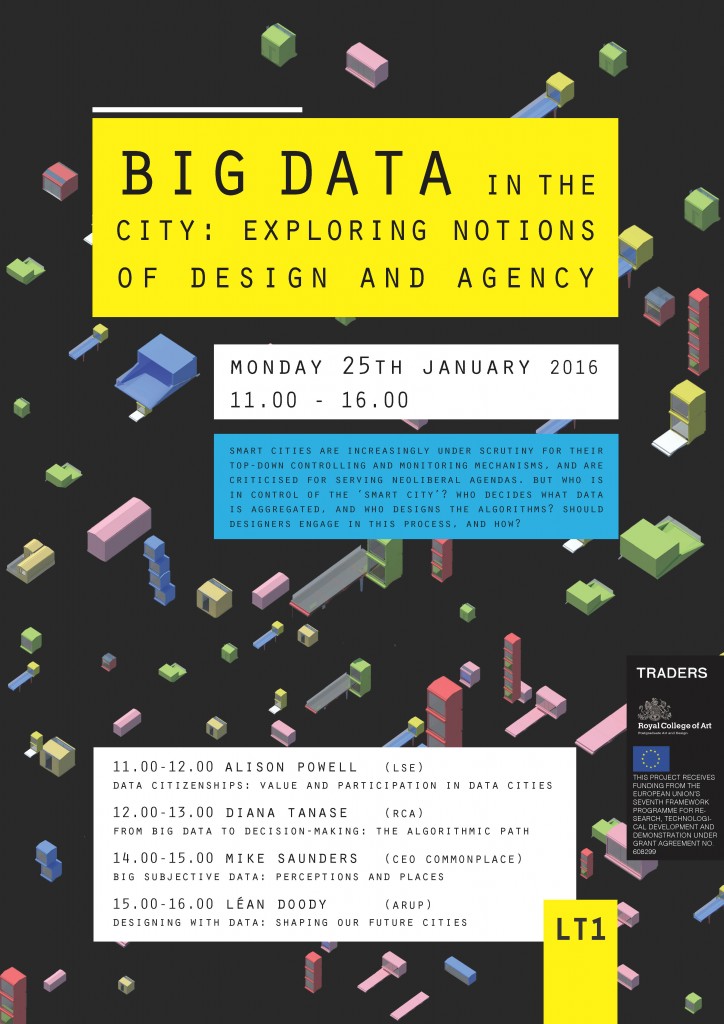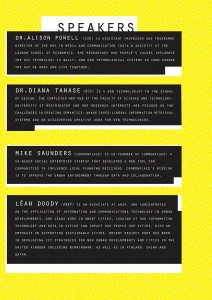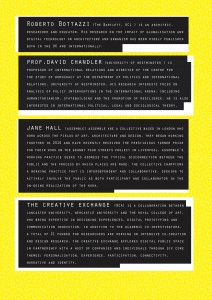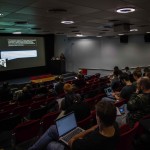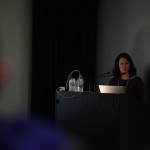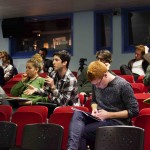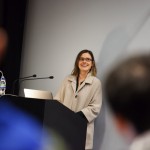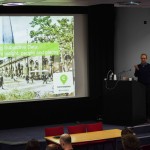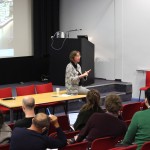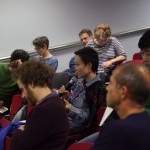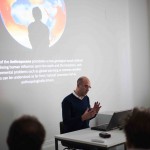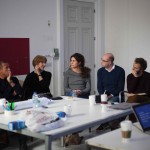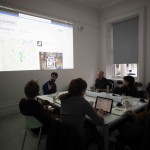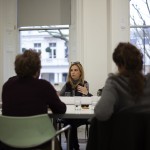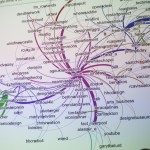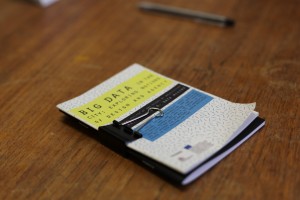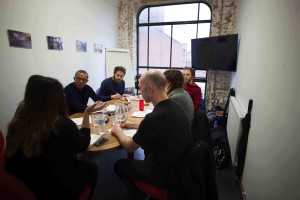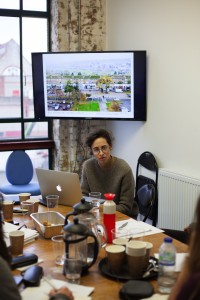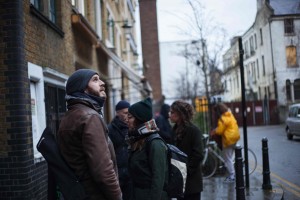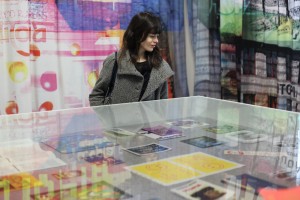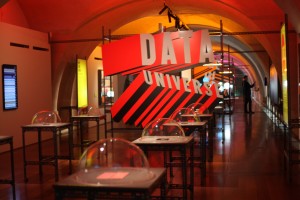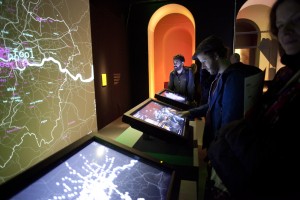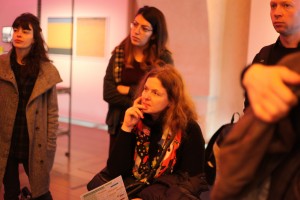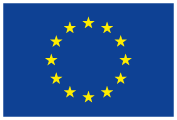Fourth TRADERS Training Week: ‘Big Data in the City’
The fourth training week (i.e. Training through Research Synergy Week) of the TRADERS project took place at the Royal College of Art, London from the 25th-28th of January 2016 and was hosted by Saba Golchehr, TRADERS researcher and PhD candidate in the School of Architecture.
The theme of this fourth training week focused on the TRADERS approach ‘data mining’, and the week’s programme was titled: ‘Big Data in the City: Exploring Notions of Design and Agency’. The programme of the week consisted of an opening symposium, lectures, workshops, a reading group, an exhibition and discussions/reflections.
Day 1 – Monday 25 January
Open Symposium: Big Data in the City: Exploring Notions of Design and Agency
We opened the training week with a symposium open to all students from the RCA. The goal of hosting an open event was to attract RCA students interested and working in similar fields. In this symposium we explored and discussed notions such as data in urban design, ‘smart cities’, civic empowerment and (the power of) algorithms. A variety of speakers from both academia and practice were invited to speak about these topics from different fields of expertise.
The event was opened by Professor Susannah Hagan, who welcomed the training week participants and took them on a brief journey through the history of the Royal College of Art.
The first speaker of the symposium was Dr. Alison Powell from the London School of Economics, who talked about ‘Data Citizenships and Data Cities’. In her research she focuses on the participation and communication of and between people. In her talk she emphasized on seeing data as a construction of data infrastructures representing a materialisation of social struggle, connected to questions about the rights citizens have to participate and enact their citizenship. This question is especially relevant now, in a time where the notion of citizenship is breaking apart, and both notions of citizenship as well as democracy are becoming liquid. One way to explore this new fluidity, she introduced, is by looking at the city, where citizenships are a bit more fluid, contested and maybe even more problematic. She also stated that technology has always been part of this discussion of citizenship, referring to Simmel (1903), a classic sociologist of cities. Within modernity, technologies have always been viewed as a possibility to transform, augment and enhance our being together in cities and spaces. However, technology is also there to enable a certain amount of order and control. She continued by exploring further the tension of ‘smart city’ promises, which on the one hand constrain and control but at the same time provide opportunities to do things differently. Between the top-down and the bottom-up, there is always a promise that things can become radically different. And while there is pressure to save money and ‘roll back’ the state, governments may shift from seeing citizens as those with civic responsibilities and engagements, to classifying them as consumers who purchase services from providers. As designers, Alison proposed, our role is to think about how we make decisions.
The second speaker was Dr. Diana Tanase from the Royal College of Art. Diana spoke about algorithmic decision making with the use of Big Data and introduced us to the mathematic notions that are part of this kind of data analysis.
After a lunch break, we continued with our third speaker of the day, Mike Saunders of Commonplace. Mike spoke about his own motivation of developing such a civic platform for engaging a wider range of participants to community consultation processes, and explained how the Commonplace tool was used in different projects.
The final speaker of this Big Data symposium was Léan Doody of Arup. Léan showed several examples of smart city technologies that are being applied around numerous cities and countries at the moment and questioned the effects and ‘success’ of such implementations.
- Speaker details
- Speaker details
Day 2 – Tuesday 26 January
The themes of the second day of the training week were: Big Data in a Historical Context, Social Media Data and Network Visualisation
We started this second day with a lecture by Roberto Bottazzi, who in his talk placed Big Data in (architectural) design in a historical context. He first gave an introduction into different terminologies and explained the difference between data, information and knowledge. Following this, he introduced two case studies. The first was Buckminster Fuller’s World Game and the second case study existed of Stafford Beer’s project Cybersyn in 1970s Chile.
The second session of this day focused on research networks. Tom Simmons, research leader in the School of Communications and coordinator of the Creative Exchange (CX) research project at the RCA gave a talk about the value of research networks such as the CX project and TRADERS for knowledge production in both inside and outside academia (industry, public sectors, etc.).
In the afternoon we continued the discussion on research networks and how we have experienced working within such a network, together with three CX PhD students; Veronica Ranner, Susannah Haslam and Jimmy Tidey. The presentation of Tom Simmons and the discussion afterwards helped us move forward in our conceptions in what TRADERS is, how it has added to our individual PhD experiences, and how we believe the project should be communicated through the different outputs that we plan to produce in this last year of the project.
We continued the discussion on network data and visualisations in a workshop hosted by Jimmy Tidey (PhD student of the CX project in the School of Communications at the RCA). In preparation of this workshop Jimmy and I had collected Twitter data from Genk and Hasselt to show the participants what actors the two towns were connected with. We used a tool called Localnets (www.localnets.org), developed by Jimmy, to collect and visualise this data. Another data set that we looked at was the Facebook data aggregated from the TRADERS Talk Facebook page. I used Gephi (a network-data visualisation software) to visualise our Facebook data showing the connections with other pages (i.e. groups) and the ‘likes’ for posts by TRADERS Talk.
- Day 1 – Open Symposium
- Day 1 – Talk by Alison Powell
- Day 1 – Big Data Symposium
- Day 1 – Talk by Diana Tanase
- Day 1 – Open Symposium
- Day 1 – Talk by Lean Doody
- Day 1 – Open Symposium Q&A
- Day 2 – Talk by Roberto Bottazzi
- Day 2 – Talks & discussions
- Day 2 – Talk by Jimmy Tidey
- Day 2 – Group Discussions
- Day 2 – Network diagrams on Hasselt & Genk (BE)
Day 3 – Wednesday 27 January
The themes of the third day were: Big Data and New Epistemologies and Community Engagement in Public Space
The third day took place in the Arcola Theatre in Dalston, East London. This area of London has been subject to numerous redevelopment plans from private developers and local councils with the goal to attract different (higher) income groups, resulting in a gentrification of this area. I chose this location to show the participants the current problematic of gentrification in this borough and had planned a public space tour at the end of this day to visit some spaces which were designed with and for the community by architecture studio Muf in order to give local stakeholders agency in the redevelopment of their neighbourhoods.
In the morning we had a reading group session with David Chandler. In this session we reviewed the readings that were part of the preparation of the training week. One of the readings was an article by David Chandler about new epistemologies and Big Data. In this session he introduced us to some of his conceptions on the digital vs. the analogue, Deleuzian and Foucauldian interpretations of the data society, the Anthropocene, and many other fascinating themes. In this session we discussed how these notions related to the ‘human’ and to design. In the first part of the session David took apart the theme of ‘Big Data in the city’ through these different notions and questioned the influence of data in society by taking human agency out of the equation. In the second part we collectively problematized the concepts he raised and tried to close the circle by placing the human back into the equation as a central factor, and started questioning what this would mean for the role of design and designers in a data city.
In the afternoon session we focused on public space and community engagement in the design of public space. Our first session this afternoon took place through a talk by Jane Hall from the Turner Prize winning architecture collective Assemble. Jane presented some of Assemble’s public space projects in the UK in which they collaborated with local communities. Some of their projects were temporary interventions and some long-term projects, but in all their projects they focused on the programming of the space as well as the design, as a means to activate the public space and attract different user groups to experience the space in different/new ways.
The last session of this day existed of a short talk followed by a public space tour by Aranzazu Fernandez Rangel of Architecture studio Muf. Their practice has developed a public space strategy for Dalston (located in the borough of Hackney), in which they mapped local stakeholders and with this aimed at incorporating them in the redevelopment process of the area by giving them a voice in the decision making process. As part of this strategy the studio also redeveloped several local public spaces in collaboration with or for the local community. They produced a report containing the outcomes of their interviews with locals about how public spaces in the area should be redeveloped, and what the needs and wishes of the locals are.
After Aranza’s introduction we went outside for a visit to two of their public space projects in Dalston. The first projects was Gillet Square, where the studio developed a ‘programme box’ and designed a small green area (http://www.gillettsquare.org.uk).
The second project we visited was Dalston Eastern Curve Garden, a local public space that has been created on the old Eastern Curve railway line which once linked Dalston Junction Station to the goods yard and the North London Line (http://dalstongarden.org).
- Programme Booklets
- Day 3 – Reading group with Prof. David Chandler
- Day 3 – Talk by Jane Hall (Assemble)
- Day 3 – Public space tour by Aranza Rangel (muf art/architecture)
Day 4 – Thursday 28 January
The theme of this fourth and last day was: Big Data in Art and Design
This last day we planned to focus on returning to our field of Art and Design and explore Big Data from this point of view. To initiate this exploration we planned a visit to the ‘Big Bang Data’ Exhibition at Somerset House in the morning. In this exhibition different artists, designers and innovators explored how data is transforming our world.
Our guide walked us through the exhibition and elaborated on some of the pieces. The exhibition existed of projects taking up different positions towards the effects and role of Big Data in today’s society. Some pieces illustrated a critical stance and portrayed the dystopian world of surveillance that Big Data has enabled. Other pieces were more playful and some ridiculed peoples’ online behaviour. There were also pieces that demonstrated how data from different social media channels can be analysed and used to visualise a different view of the city. And one project consisted of a game in which the participant can model how the City of London would look in 2036, based on the participant’s decision on housing, industry, energy developments, etc.
After the guided tour through the exhibition, the participants had time to explore the pieces by themselves while in the meantime reflecting on the notions that were raised and themes that were discussed earlier that week. After their individual reflection we met for a group discussion and reflection on the themes of this training week. After the discussion we travelled back to the RCA to finish the training week with the TRADERS management meeting.
- Day 4 – Big Bang Data Exhibition
- Day 4 – Big Bang Data Exhibition
- Day 4 – Big Bang Data Exhibition
- Day 4 – Big Bang Data Exhibition

